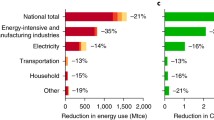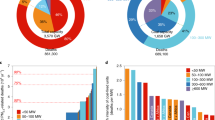Abstract
This study investigates the benefits to human health that would occur in the United States (US) due to reductions in local air pollutant emissions stemming from a federal policy to reduce greenhouse gas emissions. In order to measure the impacts of reduced emissions of local pollutants, this study considers the Warner-Lieberman bill (S.2191) of 2007 and the paper considers the impacts of reduced emissions in the transport and electric power sectors. This analysis provides strong evidence that climate change policy in the US will generate significant returns to society in excess of the benefits due to climate stabilization. The total health-related co-benefits associated with a representative climate policy over the years 2010–2030 range between $103 billion and $1.2 trillion in present value terms. Much of the co-benefit stems from between 32,000 and 189,000 avoided premature mortalities associated with exposure to PM2.5 and O3. Most of the co-benefits are due to reduced emissions of SO2 from coal-fired power plants since these are an important contribution to ambient concentrations of PM2.5. Among the most important determinants of co-benefits is the relationship between climate policy and existing policies governing SO2 discharges from coal-fired power generation capacity. If SO2 emissions are permitted to remain at current levels, total co-benefits are cut by 65%. We find that the co-benefit per ton of CO2 emissions ranges between $1 and $77 depending on modeling assumptions and year.
Similar content being viewed by others
References
Abbey DE, Ostro BE, Petersen F, Burchette RJ (1995) Chronic respiratory symptoms associated with estimated long-term ambient concentrations of fine particulates less than 2.5 microns in aerodynamic diameter (PM2.5) and other air pollutants. J Environ Epidemiol
Bell ML, McDermott A, Zeger SL, Samet JM, Domenici F (2004) Ozone and short-term mortality in 95 US urban communities, 1987–2000. J Am Med Assoc 292(19): 2372–2378
Burtraw D, Krupnick A, Mansur E, Austin D, Farrell D (1998) Costs and benefits of reducing air pollutants related to acid rain. Contemp Econ Policy 16: 379–400
Byun DW, Schere KL (2006) Review of the governing equations, computational algorithms, and other components of the models-3 community multiscale air quality (CMAQ) modeling system. Appl Mech Rev 59(2): 51–77
Cropper ML, Oates WE (1992) Environmental economics: a survey. J Econ Lit 30(2): 675–740
Hagler B (1999) Potential for fuel taxes to reduce greenhouse gas emissions in transportation, fuel tax policies report, prepared for the Department of Public Works and Government Services, Science Directorate, Science, Informatics and Professional Services Sector, Canada, June 1999
Hubbel BJ, Crume RV, Eyarts DM, Cohen JM, Richard V (2010) Crume, policy monitor: regulation and progress under the 1990 Clean Air Act Amendments. Rev Environ Econ Policy 4(1):122–138 (first published online December 22, 2009). doi:10.1093/reep/rep019
Laden F, Schwartz J, Speizer FE, Dockery DW (2006) Reduction in fine particulate air pollution and mortality: extended follow-up of the harvard six cities study. Am J Resp Crit Care Med 173: 667–672
Mendelsohn RO (1980) An economic analysis of air pollution from coal-fired power plants. J Environ Econ Manag 7(1): 30–43
Muller NZ, Mendelsohn RO (2007) Measuring the damages of air pollution in the United States. J Environ Econ Manag 54(1): 1–14
Muller NZ, Mendelsohn RO (2009) Efficient pollution regulation: getting the prices right. Am Econ Rev 99(5): 1714–1739
Muller NZ, Mendelsohn RO, Nordhaus WD (2011) Environmental accounting for pollution in the United States economy. Am Econ Rev (Forthcoming)
Nemet GF, Holloway T, Meier P (2010) Implications of incorporating air-quality co-benefits into climate change policymaking. Environ Res Lett 5
Nicol C (2000) Elasticity of demand for gasoline in Canada and the United States. Department of Economics, University of Regina, Regina
Nordhaus WD (1992) An optimal transition path for controlling greenhouse gases. Science 258: 1315–1319
Pope CA, Burnett RT, Thun MJ, Calle EE, Krewski D, Ito K, Thurston GD (2002) Lung cancer, cardiopulmonary mortality, and long-term exposure to fine particulate air pollution. J Am Med Assoc 287(9): 1132–1141
U.S. Department of Energy (USDOE) (2007) http://tonto.eia.doe.gov/ftproot/forecasting/0383(2007).pdf
U.S. Environmental Protection Agency (USEPA) (1999) The Benefits and Costs of the Clean Air Act (1990–2010) EPA report to congress. EPA 410-R-99-001, Washington, DC, Office of Air and Radiation, Office of Policy 1999
U.S. Environmental Protection Agency (USEPA) (2006) National Emissions Inventory (NEI): 2002. Office of Air Quality Planning and Standards, Emissions Inventory Group; Emissions, Monitoring, and Analysis Division, Washington, DC
U.S. Environmental Protection Agency (USEPA) (2008) Office of Atmospheric Programs, EPA Analysis of the Lieberman-Warner Climate Security Act of 2008, S. 2191 in 110th Congress, March 14
U.S. Environmental Protection Agency (USEPA) (2009) Inventory of US Greenhouse Gas emissions and Sinks: 1990–2007, EPA 430-R-09-004, April 15
U.S. Environmental Protection Agency (USEPA) (2010) Environmental Benefits Mapping and Analysis Program http://www.epa.gov/air/benmap/models/BenMapManualSept08.pdf
U.S. Environmental Protection Agency (USEPA) (2010–2012) EPA’s Updates to EPA Base Case v3.01 from EPA Base Case 2006 (v3.0) Using the Integrated Planning Model (IPM) http://www.epa.gov/airmarkets/progsregs/epa-ipm/docs/Documentation%20for%20EPA’s%20Base%20Case%20v3.01%20Using%20IPM.pdf, 2010–2012
Viscusi WK, Aldy JE (2003) The value of a statistical life: a critical review of market estimates throughout the world. J Risk Uncertain 27(1): 5–76
Viscusi WK (2004) The value of life: estimates with risks by occupation and industry. Econ Inq 42(1): 29–48
Woodruff TJ, Parker JD, Schoendorf KC (2006) Fine particulate matter (PM2:5) air pollution and selected causes of postneonatal infant mortality in California. Environ Health Perspect 114(5): 786–790
Author information
Authors and Affiliations
Corresponding author
Electronic Supplementary Material
The Below is the Electronic Supplementary Material.
Rights and permissions
About this article
Cite this article
Groosman, B., Muller, N.Z. & O’Neill-Toy, E. The Ancillary Benefits from Climate Policy in the United States. Environ Resource Econ 50, 585–603 (2011). https://doi.org/10.1007/s10640-011-9483-9
Accepted:
Published:
Issue Date:
DOI: https://doi.org/10.1007/s10640-011-9483-9




